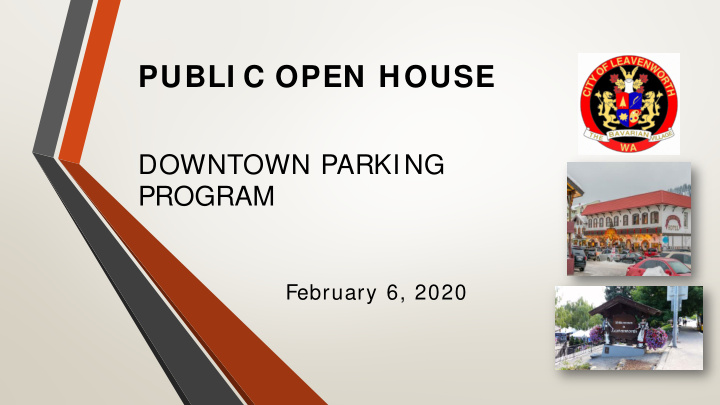



PUBLI C OPEN HOUSE DOWNTOWN PARKING PROGRAM February 6, 2020
Program Format • Introductions • History • Options • Smart Meter Technology • Next Steps • Q & A • Adjourn
2017 Parking Study Community Developed Guiding Principles: • Get the right parker to the right stall. • Ensure convenient affordable, available parking for customers and visitors to the downtown. • Make it easy for employees to park in places not in conflict with customers and residents. • Ensure residents and their guests have priority access on neighborhood streets. • Promote walkable environment and alternative modes. • Clearly communicate how and where to find available parking. • Plan for and respond to increasing demand for parking. • Parking pays for parking.
On-street performance
2017 Parking Study Findings: • 85% or more of the parking available supply is routinely occupied constraining availability for customers and visitors. • A significant portion of our downtown parking is used by employees who work downtown and park on the street close to employment. • Average length of stay/use of parking stall was under three hours (2 hours and 45 minute). This average number also includes those long term/employee parkers. No-Limit Parking in Core is not consistent with average time stay. • - There is no control of core • - Consider time limits • Demand for parking decreases after 4:00 PM. • Remote lots and shuttle is positive add to the system. • Up to 181 stall deficit in public parking supply. • Begin planning for capacity growth and how to fund.
0 – 1 year 1 – 2 years 2 – 3 years 3 years+ Organization Policy and Improve On- Increase Enhance Provide New Improve Off- Code street system Awareness Alternative Capacity street system • Focused staff Modes • 3 Hour parking point person • Form SAC in core • Upgrade • Shared Use • Find sites • SAC • 85% Rule • 5 hour parking signage and • Bikes • Employee Participation • Find funding • Approve on commercial brand • Shuttles Permit • Routine Data • Partnerships outside of Core non- • Stripe on- • Increase program Collection accessory • Buil d • Evaluate paid street stalls transit • Variable parking parking (3 • Maps and pricing years) webpage Protect Neighborhoods • Area Permit Program (APP) – Policy and Process • Initiate at request of neighborhoods Parking Strategy Flow
2019 Parking Advisory Committee Parking Plan Development: Timed Parking vs Metered Parking • Timed parking costs money for install and enforcement without a consistent revenue stream. • Timed and metered parking: • Pays for itself and potentially generates a revenue stream to pay for future parking improvements. • Enforcement is more efficient, promotes fairness of system. • Smart meter system provides users with information on where parking is available. • Active Parking Management vs Passive Parking Management • Need to have the tools. • Data driven decisions.
2019 Parking Advisory Committee Parking Plan: Smart Meters, Timed on Street Parking, with Sensors • 3 hour max. on-street parking/15-25 minutes free parking (TBD). • Full day parking in City owned surface lots – price varies with location. • Pay by card or mobile app. • Sensors provide customer information on where parking is available – on-street and surface lots. • Residential Parking Permit as a part of program. • Employee Parking Options – over 150 free stalls within City limits. • Smart Card tool allows for many options.
Residential Parking Permit • Adopt Municipal Code to enact the program. • Free Parking with zone permitted vehicles. • 2 hour limited parking without zone pass. • Intended to be a step-by-step process initiated by the neighborhood blocks. • Not required by City. • Restricting the use of curb space to prioritize residential and short term guest parking over commuter and long term visitor parking.
Employee Parking Options • Lots 1-4 are paid lots, pricing reviewed and possibly readjusted to promote long- term parking in surface lots. • Lot 5, 6 and PR lots are free parking. • PR lots and Lot 6 can be accessed with free shuttle service every 15 minutes.
CivicSmart’s LNG Smart Parking Meters • Convenient to Use • Single and Dual Space Meters for on-street spaces • Easy to Pay • Credit/Debit Cards • Smartcard option • Multiple Mobile Payment Apps • PCI Compliance for Security
Paystations in the Parking Lots • Paystations Cover Multiple Spaces • Same Easy to Pay Options • Credit/Debit Cards • Smartcard option • Multiple Mobile Payment Apps • PCI Compliance for Security
Smart Parking System • Vehicle Detection Sensors advise visitors and residents where to find vacant spaces via apps and maps • Detailed occupancy information supports data- driven policy decisions (hours, days, rates, etc.) • Efficient enforcement encourages compliance
2019 Parking Advisory Committee Parking Plan Options To Be Determined: • Pricing not set and can be dynamic • Pricing flexes throughout the year based on demand. • Change in surface lot pricing. Longterm parking should be in surface lots, price varies with location. • 3 hour max. on-street parking/15-25 minutes free parking (TBD). • Smart card options provide tool for implementing discount programs. • Alternative employee parking options developed as behavior changes and information becomes available.
Next Steps City Council Contract Consideration with Civic Smart Additional Public Outreach to discuss: Pricing Smart Card Utilization Employee Parking Options
Questions and Input
Thank you!
Recommend
More recommend